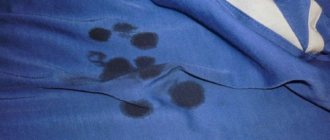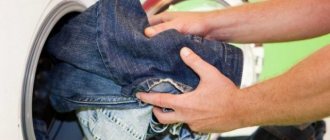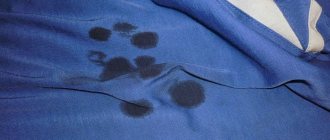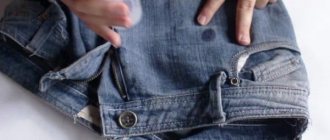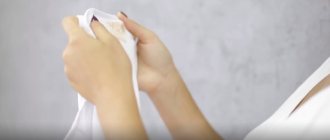Many housewives are faced with the problem of paint on clothes. Removing such stains requires patience and effort. This is especially difficult to do with items made from delicate fabrics. This article discusses practical tips using available tools available in every home. After all, it so often happens that your favorite thing gets dirty completely by accident. And if there are children in the family, then there can be a great variety of such things. After all, children never sit still, they explore everything, and stains appear on their clothes both from gouache and watercolors, and from other paints, such as water-based paints.
Sometimes removing stains takes time and effort
Basic Tips
In order to begin removing paint stains from clothes, you first need to figure out what kind of paint it is. Depending on the composition, the right decision will be made on how to dissolve it and remove it. But it should be borne in mind that everything depends on the material of the thing on which the stain was found and, most importantly, on its age.
Rules for removing paint:
- The sooner you wash a soiled item, the greater the likelihood of removing the stain.
- When treating a stain, you must first put a cotton cloth underneath it, folded several times. This will ensure that the rest of the product is clean and only the contaminated area can be processed.
- Before applying the removing agent to the entire stain, it is necessary to test its effect on an inconspicuous area of the product in order not to spoil the product.
- It is recommended to clean items made from delicate fabrics from the inside out to avoid unpleasant consequences.
- In order to avoid increasing the size of the dirt, you need to wipe from the edge to the center, and not vice versa.
After removing the dirt, it is advisable to first wash the item by hand, especially carefully in the areas where the paint has been removed. Then load it into the washing machine, using powder and always a little special stain remover, wash it, rinse well and hang it out to dry.
How do you remove paint stains?
Let's consider these types of paints that can be produced at home:
- for drawing - gouache, oil, watercolor, tempera;
- latex and acrylic;
- stamp;
- alkyd (enamel and oil).
Rules for removing enamel from clothing
It's easy to remove enamel from clothes if you start washing before the stain dries.
Enamel paints have gained their popularity due to the formation of a durable and smooth protective layer, increased resistance to temperatures and detergents. For operational requirements, such characteristics are always useful, but difficulties often arise in situations where it is necessary to remove enamel from clothing.
Paints for painting
Most often, children's things suffer from painting paints.
Watercolor and gouache are substances that dissolve in water. If you immediately wash away the stains left by them, they will wash off quite easily. To do this, first the product should be rinsed under running cold water until the residual color (pale) remains and/or soaked in water with powder (depending on the size and saturation of the defect). Then wash either by hand or in a washing machine with a large amount of powder, choosing the longest cycle.
Important! To prevent the paint from eating into the fibers of the product, the water temperature should not exceed 30 degrees.
Most often, children's things suffer from painting paints.
If you did not have time to remove a stain that has just appeared and you need to remove an old one, then you can use one of the proposed methods:
- use laundry soap, thoroughly rubbing the stain;
- apply a stain remover for this type of fabric;
- pour a little heated vinegar onto the stain (cannot be used on delicate items).
After using any of the proposed methods, you should leave the item for 1 hour and then wash it.
Tempera and oil paints contain oil. Dish soap (detergent) can help rid the item of their traces. We rinse the stain under cold water, pour the detergent onto the fabric and leave for half an hour (an hour), then wash it by hand. If the stain is old, you should also use a stain remover.
What to do if the contamination is old
Even if the enamel stain has become old, you should not be upset, because effective removal methods have been invented. First you need to make the surface of the drop softer by greasing it with butter or margarine. After this, wipe with kerosene or gasoline, and then wash thoroughly. Keep in mind that gasoline for these purposes must be purified and of high quality. The use of questionable products can lead to even greater contamination.
Traces from different types of varnish, paints and enamels can be effectively removed from clothing, carpet, and furniture. The main thing is to do everything according to the rules: choose the appropriate product wisely and clean strictly from the edges to the middle to avoid the appearance of unaesthetic stains.
Stamp paint
Clerical office workers periodically have difficulty removing stamp ink stains after carelessly refilling seals or stamps. To remove them at home, the following methods are proposed:
- Mix mustard powder with water until a paste forms. Cover the stain with it and leave for 24 hours. After a day, scrape off the dried pulp and put the item in the wash. This method is also suitable for delicate fabrics, such as silk.
- Combine ammonia and turpentine in a 50/50 ratio. Pour the mixture onto the stain, wait until it disappears, then wash the product.
- Mix glycerin and denatured alcohol in equal proportions. Heat the mixture and, moistening a cotton swab, wipe off the dirt, soaking it. Ideal for leather goods.
Important! When working with strong chemicals, be sure to protect your hands with gloves and open windows in the room where the product is being processed.
What is the best way to remove old paint?
You can remove paint from the walls using a hair dryer. The coating should be heated until it softens, and then removed with a spatula. The main disadvantage of this method is that fumes from varnishes and paints are harmful to health. The mechanical removal method - using notches with an ax - is convenient for small surfaces.
Interesting materials:
How to set a password for an application in settings? How to set to factory settings? How to increase FPS in CS GO using Nvidia tweak? How to properly set up a wireless connection? How to configure bios correctly? How to properly configure the Google Chrome browser? How to properly configure the Google Chrome browser? How to correctly set the date on your watch? How to configure EDGE correctly? How to properly set up an electronic clock?
Acrylic and latex paint
How to get rid of dirt on clothes if it appears as a result of acrylic or latex? If you react immediately, you can act according to the scheme given for watercolor paint and gouache. If the stain is rather large, then the treatment will be more scrupulous.
Purification stages:
- Turn the product inside out, rinse with cold water and squeeze lightly.
- Using a toothbrush (preferably a soft or medium-sized one), gently rub dish detergent or laundry detergent into the affected area.
- Place the item in the washing machine and select the washing mode with the maximum temperature for washing, while carefully focusing on the fabric of the item and its washing temperature.
- If there is an old stain on silk fabric (or other delicate fabric), then you can try to remove it according to the following scheme:
- Wet the product with water and rub the dirt with laundry soap.
- Take denatured alcohol and heat it in a water bath. Using a soaked sponge, apply it to the stain on top of the soap.
- Remove paint residue using a cotton pad.
- Dry a little with a towel, sprinkle with talcum powder and leave for an hour.
- Wash.
How to remove paint from pants
In order to find a way out of the situation, how to remove paint from clothes, including your favorite pants, you need to take into account many nuances. Namely, the composition of the fabric of the product and the features of its cleaning.
As a rule, paint that has just spilled onto this item can be removed with simple detergents:
- bleach and powder;
- a brush designed for cleaning teeth or with soft bristles;
- water.
You need to remove paint stains without delay, then they can be washed off quite easily. It is important to note that you should use any cleaning product only after you have read the product label and are sure that the manipulations performed will not harm it.
You need to do the following:
- Wet the inside out pants thoroughly with cold water, without applying any cleansing agents at first.
- Then squeeze out the product and place it in the washing machine at 30 degrees.
- At the end of the wash, if the desired effect is not achieved, you can repeat it again.
- Then rub the stain with washing powder using a toothbrush.
- Load the pants into the machine and repeat the wash cycle, and the temperature can be increased to the permissible limit.
- What to do and how to remove paint stains from pants if the above manipulations did not help? Repeat washing using stain remover.
Alkyd enamel
Ways to get rid of only received contaminants:
- Take a cotton pad and soak it in white spirit or undiluted gasoline. Wipe off the contaminated area.
- Heat glycerin or ammonia and apply to the stain. It is good to rinse the item in this place and then wash the whole thing.
- Mix acetone with gasoline in a 50/50 ratio. Wipe off the dirt with a moistened cotton swab. Leave to wash.
If you are going to remove old dirt from clothes, try the following recipes:
- Mix equal amounts of gasoline, turpentine and alcohol. Pour the mixture onto the stain and leave for 60 minutes. After the paint has softened, carefully remove it with a knife. Rinse well and soap the residue with laundry soap. Extend.
- Take clean kerosene and carefully pour it onto the stain. After a minute, wipe with a piece of soft cloth soaked in ammonia. Next, washing is recommended.
- Moisten the contaminated part of the product with turpentine. After the item has been left for several minutes, blot it well with a sponge soaked in a strong soda solution. Wash.
Advice. Cotton swabs (discs) and sponges should be washed or changed frequently to avoid smearing the paint.
Special means
You can get rid of paint using special stain removers. They are sold in stores in the departments with household chemicals.
When choosing a product, you need to pay attention to the following points:
- Release form. Liquid formulations are universal, and powder detergents are not used for washing delicate items.
- Purpose of the product. There are stain removers only for white and only for colored items.
- Compound. It may include surfactants, enzymes, and active oxygen. These components carefully remove dirt without harming the fabric fibers. Aggressive substances include: chlorine, bile, acids.
Be sure to pay attention to the price of the cleaning product. Often it is overestimated not because of the effectiveness of the stain remover, but because of the brand under which it is produced.
- apply the composition to the stain (if powder is used, the fabric must first be moistened);
- leave for impact;
- rub the contaminated area;
- Wash your pants using stain remover.
Top 3 best products
You can deal with paint using the following stain removers:
- Vanish Oxi action Gold gel. Apply the product to the stain, leave for 1-4 hours, then wash as usual. The cost of a 0.45 liter bottle is 210 rubles.
Advantages of the stain remover: convenient release form, activation at low temperatures, ability to use for white and colored items, absence of aggressive components in the composition. Gel Antipyatin with natural bile. Apply the product to the stain, rub in gently, leave for 15 minutes, then wash by hand or in a machine.
The cost of a 250 ml package is 230 rubles. Advantages: activation at a temperature of 30 degrees, the ability to use for washing delicate items, the presence of natural ingredients. Udalix Ultra liquid stain remover. The spray is sprayed onto the stain, left to act for 10-15 minutes, rubbed lightly with your hands, and washed as usual.
The cost of a 150 ml spray is 260 rubles. Advantages: convenient bottle that allows you to accurately dose the product, can be used for all types of fabrics.
Oil paint
When trying to get rid of oil paint on your favorite thing, you can try the methods described above. If the oil trace is new (fresh), then you can immediately wipe it off with dish gel. If the trace is old, then recipes with acetone, white spirit, gasoline, kerosene and other substances from this group will be suitable.
Original ways to get rid of oil paint:
- Mix a teaspoon of soft butter and washing powder into a paste. Carefully apply a thick layer and rub in with a brush.
- Treat the stain with vegetable oil applied to a cotton swab.
- If the paint is already old, then pour in sunflower oil and let it soak. Then use a knife to remove the paint and wipe off the remaining residue with a brush.
When using any type of oil on fabric, a greasy residue remains, which should be sprinkled with table salt or dish gel poured on top of it. Leave for 15-30 minutes, wash in warm water.
Advice. If a stain is removed from white cotton fabric, then after removal the item should be placed in the following solution: water - 1 liter, soda - 1 small spoon, laundry soap - 50 grams and boil slightly.
Features of removing different types of dyes
To choose an effective cleaning product, you need to focus on the type of paint that got on your pants.
| Paint type | The most effective cleaner |
| Oily | Fat-based compounds: gasoline, white spirit, kerosene, turpentine. |
| Acrylic | Acetone, ammonia, alcohol compounds, solvents. |
| Water-based | Any liquid products: professional stain removers, gasoline, soap solution. |
| Hair dye | Vinegar, hydrogen peroxide, lemon juice. |
| Ink | Alcohol and glycerin, laundry soap. |
How to remove different types of paint from clothes, video tips:
Paint on jeans - tips for removing paint at home
Butter
Oddly enough, oil paint can be removed with butter. Take 75 grams of butter at room temperature and mix into a homogeneous mixture with 80 grams of washing powder for hand washing.
The resulting paste should be rubbed onto the contaminated area of the product and gently rubbed with a toothbrush. Remove excess with a paper napkin or towel. Apply the mixture again. Cover with film and leave for 30 minutes. First, wash the product with laundry soap by hand, and then load it into the washing machine and wash it with powder.
Table vinegar and ammonia
The combination of ammonia (ammonia) with table vinegar is very effective and 100% effective. It works well with paints that have a water-based (acrylic) base.
To make the mixture you will need:
- fine (or crushed) table salt* – 30 grams;
- vinegar (6 or 9%) – 65 milliliters;
- ammonia (ammonia) – 50 milliliters.
*You cannot use iodized salt - it can burn out the pigment.
A film or plastic bag is placed under the bottom of the contaminated area, and our mixture is laid out on top for 7 minutes. We take a toothbrush and clean it, and if the fabric is delicate, then use a soft cloth. Residues are washed off under running water. Can be washed by hand or machine.
Old pollution
Old paint stains should be soaked in kerosene or turpentine before cleaning. Let it sit for at least 3 hours, but it’s better to process the item in the evening and leave it to soak until the morning.
The further procedure consists of the following steps:
- Prepare a piece of material that has high absorbent properties. Put it on the table.
- Place the soiled item with a pre-soaked stain on top so that the area of contamination is above the piece of fabric.
- Cover with a cloth soaked in solvent.
- Cover everything with polyethylene to create a greenhouse effect. The length of time you wait for the result depends on the type of tissue with which the problem occurred. The more delicate the material, the shorter this period of time.
- Check the condition of the paint - it should become soft. Carefully remove it using a soft brush.
Dried acrylic paint is removed using the following method:
- Scrape off the top layer with a knife.
- Spray with WD-40.
- After half an hour, remove any remaining dirt. You may need a knife again for this.
- Wash in soapy water, rinse and dry the item.
Tip: the greasy mark left by the stain will be removed after washing the fabric with laundry soap or foam from dishwashing detergent. The item should be rinsed and dried.
Quick ways to remove paint from things
Chlorine
Most often, chlorine-containing products are used to remove dye from cotton and linen fabrics (their fibers are very wear-resistant) of white and light shades.
In the store you need to buy “Belizna”, “Perrox” or other chlorine-containing laundry detergent. Pour 6 liters of water and 80 milliliters of the purchased product into an aluminum bucket, put it on the stove and let it boil. Place the product there and boil for half an hour, periodically drowning the product with wooden tongs if it floats.
Remove the product and place it in the washing machine. If available, then select the “Heavily soiled laundry” mode for washing, add bleach (gel or powder). Dry the product on the balcony, out of direct sunlight.
Tar soap
Tar soap or laundry soap will also help remove paint. It is sold in any store or supermarket. The paint mark is wetted under water, and then rubbed with the available soap. Leave the grated product for about 2 hours. Rinse well and repeat the process 2-3 more times (depending on the degree of contamination and the result achieved). You can rub the stain with a hard sponge or brush (pay attention to the material of the fabric).
Place the item in the washing machine. Fill the powder compartment with 100 grams of baking soda and add stain remover (Sarma, Domestos, Vanish) to the adjacent compartment. We use intensive washing. Dry the product without direct exposure to ultraviolet radiation.
Hydrogen peroxide and lemon
In some cases, even lemon helps.
Pass the lemon through a meat grinder or grind it with a blender to obtain a porridge-like mixture. The contaminated area is moistened with peroxide, and lemon pulp is laid out on top and rubbed in. After 60 minutes, remove excess with a paper napkin or towel. If the result is not satisfactory, then repeat until the desired result is achieved.
You can replace hydrogen peroxide with Chlorhexidine, which is also sold in pharmacies. It has identical composition.
Important! If a stain needs to be removed from colored fabric, then the advice is to not use peroxide, only lemon juice.
After all steps, wash in a machine or by hand.
Vinegar essence
Vinegar essence and food vinegar are not the same thing. The essence has a concentration of 65-70%, and table vinegar - 6-9%. The fact that the essence is used in production to improve the brightness of fabric and strengthen the structure is little known. But if you know the correct proportions, then vinegar essence can be used at home for all colors and types of fabric.
To soak a stained cloth, mix 75 milliliters of essence and 3.3 liters of filtered water. Place clothes in the solution for 1-1.5 hours. Then wash in a washing machine. If the contamination is small, it should be treated locally.
How to remove a fresh stain
If you notice that there are drops of enamel on the linoleum, it is better to remove them immediately before the pigments are ingrained into the floor covering.
Please note: Scope and properties of ceramic paint
So, if a stain has formed from water-based enamel, you can remove it with a paper napkin. And ordinary wet cleaning will consolidate the effect.
The acrylic base is more difficult to wipe off; here you will need vegetable oil, which will help remove any traces that appear. If you don’t have vegetable oil on hand, you need to clean the damaged area with ordinary soap. It is better to choose a fragrance-free, household product; it better removes traces of work done. Soap the floor, leave for 5-10 minutes and you can remove marks with napkins.
If drops of oil paint get on the floor, they can be easily removed using solvents. Apply the solution to a rag and wipe the damaged area. There is no need to rub too much, but act on a specific area.
But the main thing to remember is that before painting, you need to cover all open areas with thick plastic film. The algorithm of actions is as follows:
- Remove all furniture from the room.
- Wrap everything with plastic wrap.
- Secure it in the corners of the room.
Then you won’t have to think about how to remove paint from linoleum.
Vegetable oil
Paper napkins
Read more about “eliminating” gouache stains from clothes
Vinegar, salt and ammonia
The mixture is prepared in the following proportions: salt - 30 grams, vinegar 9% - 60 milliliters, ammonia - 30 milliliters. The finished gruel is distributed over the contaminated area and left for 10 minutes. Afterwards, it is removed with a brush, and the item is washed with powder.
Important! This composition is quite rigid in its properties. It is only used to remove enamel, water-based paint or oil-based stain.
Acetone
It is also quite harsh and not suitable for delicate fabrics. You can take acetone, both in its pure form and nail polish remover. Wet a cotton pad or swab and wipe the paint from the edges of the stain to the center. You can first pour acetone and then rub. At the end, as always, do the usual washing of the entire product.
White Spirit
The contaminated area is wiped with white spirit until the paint disappears. Substances similar in action: kerosene, acetone, gasoline.
Soap
If suddenly after dyeing your hair there is a mark left on your clothes, then you should rub it with laundry soap and leave it for 30-60 minutes, and then wash it in a washing machine or by hand.
There are many ways to remove paint stains from clothes. We recommend: do not panic, quickly find your bearings and determine what type of fabric and paint you have, as well as the size of the disaster. It is advisable to use gentle methods first, and based on the results obtained, determine further actions.
All of the above methods of removing paint are used very carefully when working with fabrics such as silk, viscose, wool, and fine synthetics.
Attention! You should never wrinkle, twist or pull the fabric, no matter how you decide to wipe off the paint, and what kind of fabric you will be manipulating on. Whatever method you choose, you must act carefully!
Folk recipes
If the paint has already dried, you can remove it from your pants using improvised means. For this purpose, both classic solvents (gasoline, turpentine, kerosene) and food products, for example, soda or vinegar, are used.
Laundry soap
Laundry soap is one of the safe and effective means for removing paint stains from pants.
How to use it:
- Wet the stain with cool water.
- Lather it with laundry soap.
- Rub the stain with a brush.
- Leave to have an effect. If the paint is durable, for example, acrylic or oil, then you can soak the pants overnight.
- Wash the product as usual.
If it was not possible to get rid of the stain the first time, the procedure can be repeated, increasing the soaking time of the item.
How to remove dried stains with vinegar?
Vinegar is an effective stain remover. You can use it to get rid of dried paint on your pants.
Mode of application:
- vinegar is applied to a cotton pad;
- wipe the stain with it until it completely disappears;
- wash trousers as usual.
If it was not possible to deal with the stain, then the procedure can be repeated, strengthening the recipe with ammonia. The ingredients are mixed in equal proportions.
Hydrogen peroxide
You can get rid of paint on pants using hydrogen peroxide. It perfectly dissolves hair coloring products, watercolors, gouache, and inks.
How to use it:
- Peroxide is applied directly to the stain and spread using a cotton pad.
- Leave to act for 15-30 minutes.
- Wash the item as usual.
Peroxide removes paint, but does not harm fabric fibers and does not leave behind greasy stains or streaks. Therefore, it can be used to clean pants many times.
How to remove with alcohol and glycerin?
Glycerin, in combination with alcohol, works no worse than oxygen stain removers. These components are used as follows:
- apply vodka or alcohol to the stain;
- soak a cotton pad in glycerin and begin to rub the contaminated area;
- After removing the dye, the pants are washed as usual using powder.
Petrol
Gasoline dissolves oil-based paints well. To remove stains from clothes, you need to use a cleanser. It is used to refill lighters.
Mode of application:
- Apply gasoline to a cotton pad.
- Saturate the stain with it, leave for 5-15 minutes to have an effect.
- Remove the stain with a swab.
- Wash pants in warm soapy water.
Gasoline is flammable. Therefore, you need to work with it away from sources of fire.
The most famous solvent is Galosh gasoline. The cost of a 0.5 liter bottle is about 55 rubles.
How to clean with soda?
Baking soda helps get rid of stains on light-colored clothes. It leaves no streaks or greasy marks behind. It can be used to remove paint containing an oil component.
Mode of application:
- Dissolve a tablespoon of soda in 1 liter of water.
- Place the enamel basin on a gas stove and bring to a boil.
- Pants are dipped into the solution. Soak the area that was stained with paint.
- Boil for several minutes.
- Wash the item as usual.
Turpentine
Turpentine is one of those products that does not harm fabrics. It can be used to remove paint from pants made from delicate materials.
How to use it:
- apply turpentine to a cotton pad;
- use it to process the trousers from the front and back sides;
- leave to act for 10 minutes;
- blot the stain with paper napkins and rub with a cotton pad again;
- leave for an hour;
- Wash your pants as usual.
If it was not possible to get rid of the stain the first time, the procedure can be repeated.
How to remove solvent contamination?
To remove paint, you can use solvent 646 or another similar composition that was left in the house after renovation.
Mode of application:
- Apply the composition to the contaminated area.
- Leave for 15 minutes.
- Wash your pants in the washing machine.
How can you clean black and white trousers?
Black trousers should be washed carefully, without using aggressive agents, such as solvent 646 or acetone. You can use:
- turpentine;
- laundry soap;
- professional stain removers for washing colored laundry.
If the trousers are white, then use such means as:
- alcohol;
- soda;
- glycerol;
- soap solution;
- solvents;
- white clay and refined gasoline;
- ammonia.
Enemies of acrylic
If acrylic paint appeared on clothes a long time ago, it will be difficult to deal with it. Try using solvent solvents and then use an ammonia-vinegar mixture.
Ammonia and vinegar
Peculiarities. A mixture of ammonia and vinegar will also help remove acrylic paint stains from clothes. To enhance the effect, add regular table salt to the main components.
Let's start washing
- Mix vinegar and ammonia. The components must be taken in the same quantity - two tablespoons each.
- Add salt to the mixture. You will need about a tablespoon, but you can use your eye - the paste should turn out runny.
- Apply the mixture to the stained cloth.
- Scrub gently with an old toothbrush.
- Wash it. Use the normal wash cycle for the garment.
Video on the topic

